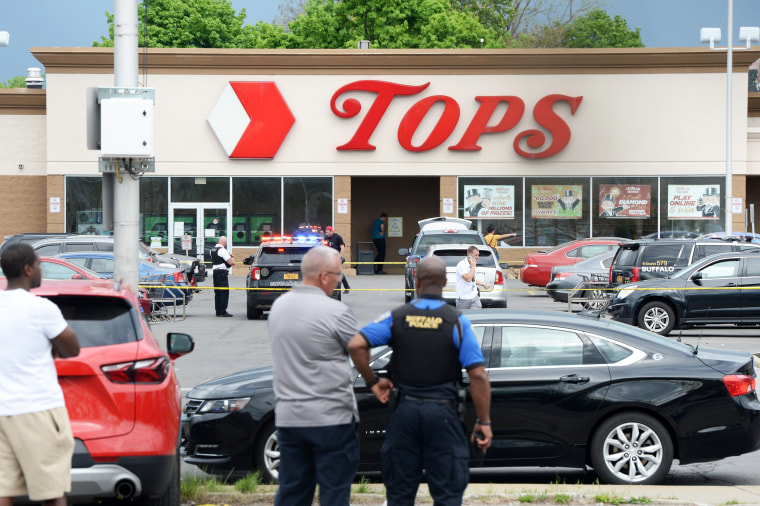The recent act of targeted mass violence against Black Americans at a Tops Friendly Market in Buffalo, New York, is yet another reminder that accelerationist, neo-fascist lone-actor violence remains one of the dangerous domestic terrorism threats in the United States today.
Best understood as a set of tactics and strategies explicitly designed to put pressure on and exacerbate latent social and societal divisions in order to collapse the system, experts believe neo-fascist accelerationism has been the inspiration for some of the deadliest acts of mass violence in the United States in recent years — from Black churchgoers in Charleston, Jewish congregants at synagogues in Pittsburgh and Poway, and Latino shoppers at a Walmart in El Paso.
Transnational accelerationist networks, designed not around formal material support but a shared community, create an in-group and interconnected online ecosystem for many of these terrorists.
Transnational accelerationist networks, designed not around formal material support but a shared community, create an in-group and interconnected online ecosystem for many of these terrorists. This creates a far more amorphous and decentralized threat picture. As such, the understanding of these networks must extend far beyond the narrow confines of traditional, group-centric counterterrorism structures and policies. Long gone are the days when a membership card or pledge of allegiance to a foreign violent extremist group were the primary red flags. Without significant changes in how we approach and respond to the realities of domestic terrorism, the tragedy in Buffalo threatens to become just one more in a long line of deadly terrorist attacks in the United States.
Primary source evidence from the suspect’s manifesto and Discord posts, which must be treated with a degree of skepticism, nonetheless provide a valuable framing for understanding the progression of radicalization and indicates an ideological adherence to tenets of neo-fascist accelerationism. For example, the emulation of believed accelerationist Brenton Tarrant, who killed 51 people in a terrorist attack targeting two mosques in Christchurch, New Zealand, was evident from the text of the manifesto — which replicated or mimicked large portions of Tarrant’s own writing — as well as the iconography on the weapon used, the use of livestreaming and the suspect’s planned public release and distribution of the video. Further, the Tops suspect’s writings show numerous references to white supremacist and antisemitic conspiracies such as the "great replacement theory" and the narrative of “no political solution.” These conspiracies and narratives, which have been embraced by accelerationist movements as foundational elements of in-group identity, serve to unite disparate elements of the right behind shared enemies.
The great replacement theory is a white supremacist conspiracy which argues that white, European populations are being intentionally replaced through migration. Initially emerging out of right-wing spaces in Europe, including the French group Generation Identity, the narrative quickly found a receptive audience in American right-wing extremists intent on framing the debate around immigration.
Narratives and rhetoric that situate every flashpoint as a defining battle in an ongoing culture war for the fate of the nation are dangerous. But they are becoming increasingly mainstream. Continued rhetoric from politicians and major news personalities has brought the underlying claims of the great replacement theory squarely to the forefront: December 2021 polling from the Associated Press and NORC found that 58 percent of respondents were extremely, very, or somewhat concerned that “native-born Americans are losing economic, political, and cultural influence in this country because of the growing population of immigrants,” while 32 percent strongly agreed or somewhat agreed with the statement that “there is a group of people in this country who are trying to replace native-born Americans with immigrants who agree with their political views.”
Online, as the suspect’s purported radicalization pathway indicates, incubators like 4chan can provide actors with a shared sense of belonging and community, which in turn fosters further ideological alignment. Indeed, research has continually highlighted the significant role of chan sites — anonymous, image-based online message boards in which users coalesce into specific niche communities — in contributing to and encouraging violent discourse, and their central role facilitating an “in-group” status that is central to the radicalization process.
Online ecosystems glorify, support and inspire the actions of the perpetrators, and they feed off the conspiracies which continue to be promoted by the mainstream right in the United States. This bidirectional transferal of dangerous narratives pushes more and more Americans deeper down the rabbit hole of violent conspiracies and political violence.
In numerous instances of mass violence to date, online incubators have been referenced as significant factors in the decision by terrorists to take action against their perceived enemy. For example, before committing his attack, Tarrant posted a call to action on the /pol/ board of 8chan, before sharing links to his manifesto and a link to the video of his attack. For accelerationists like Tarrant and the Tops suspect, showing their supporters and like-minded individuals exactly how they prepared and executed their activity may be nearly as important as the act of violence itself. The goal is not only to take kinetic action against the enemy, but inspire others to follow in their footsteps, and to use the operational and tactical guidance left in their respective rantings to engage in future acts of violence.
As the mass shooting in Buffalo indicates, the mainstreaming of white supremacist narratives and grievances has become a significant factor in the radicalization and mobilization of domestic terrorists who adhere to neo-fascist accelerationism. The threat of domestic terrorism today is no longer confined to one group, one country, or the dark underbelly of the internet — it has seeped into political speeches, prime time cable news, and both mainstream and niche social media platforms. Meanwhile, the spread of once-niche conspiracy theories like the great replacement into mainstream societal discourse only increases the risk of radicalization, and the potential for future acts of mass violence in the homeland and beyond.
